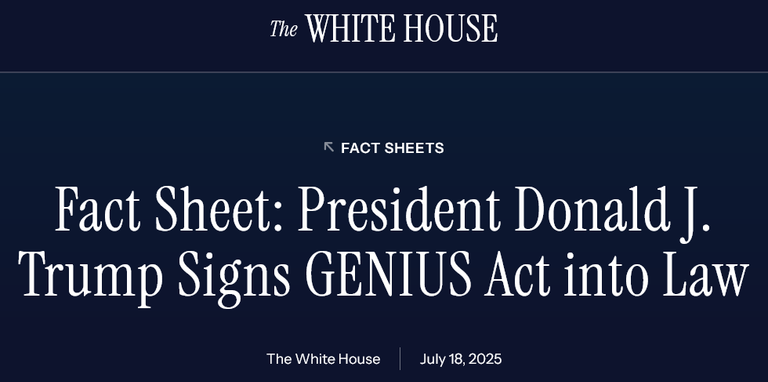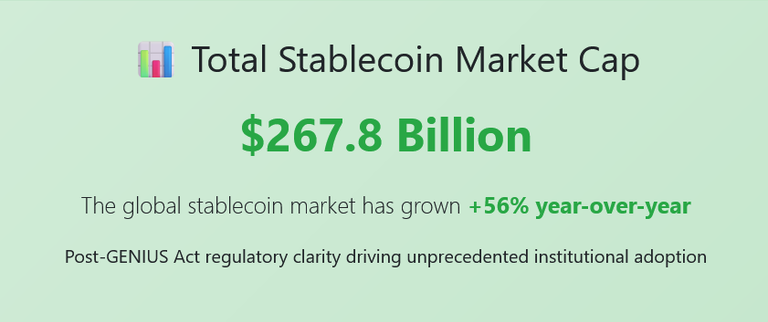The GENIUS Act: A New Era for Crypto Dollars and U.S. Treasuries
The GENIUS Act just reset the board
On July 18, 2025, President Trump signed the GENIUS Act (Guiding and Establishing National Innovation for U.S. Stablecoins), the first federal framework for payment stablecoins in the U.S. It hardwires 1:1 reserves in cash, short‑term Treasuries, or overnight repo, splits oversight between bank regulators (for banks/credit unions) and the OCC for federally licensed non‑banks, and adjusts bankruptcy priority to protect stablecoin holders.
Crypto prices immediately jumped. The market read it as regulatory clarity—a green light for bigger money flows into crypto rails.
What the law actually does
Key points:
- Defines “payment stablecoins.” No more yield-bearing coins disguised as “digital dollars.”
- Mandates 1:1 high‑quality liquid reserves (cash, ≤93‑day Treasuries, ON‑repo).
- Supervision lanes: bank regulators for banks; OCC for non‑banks.
- Bankruptcy priority favors stablecoin holders.
- Foreign issuers get a three‑year window to comply or geo‑block U.S. persons.

Click Here To See White House Fact Sheet
Why crypto ripped on the headline
With GENIUS, the U.S. finally has federal-level rules, not a patchwork of state licenses. Banks and payment companies now have a legal playbook for stablecoin integration.
Stablecoins are already a $260B+ market, with USDT dominating. The Act signals a regulated pathway for that number to explode.
Short-term impacts
- Licensing rush: Non-bank issuers will scramble for OCC charters.
- Product redesign: The ban on issuer-level interest forces yield into DeFi wrappers and tokenized T-bill funds.
- Treasury demand: Expect billions flowing into T‑bills as stablecoin reserves get standardized. The Fed’s ON RRP facility will likely drain faster.
Long-term effects: The crypto-dollar → Treasury loop
GENIUS locks stablecoin growth to Treasury demand, effectively creating a pipeline where crypto dollars backstop U.S. government debt.
Winners:
- The U.S. Treasury (more demand at auctions).
- Banks and custodians managing the reserves.
- Crypto markets (institutional credibility).
Risks:
- Treasury market shocks or debt-ceiling standoffs now directly impact stablecoin liquidity.
Real-time tracking of all major stablecoins and market trends
Will foreign issuers have to park collateral in the U.S.?
Not every foreign bank is forced to hold U.S. collateral, but access to U.S. markets comes with strings. After the three-year grace period, foreign issuers must either comply or geo-block U.S. users. This effectively pulls global stablecoin reserves onto U.S. soil.
DeFi and tokenized deposits
DeFi isn’t dying; yield will shift to middleware:
- Tokenized money market funds.
- Repo-backed tokens.
- Offshore synthetic stablecoins.
Banks, on the other hand, are now free to experiment with tokenized deposits since they fall outside GENIUS’s rules.
What to watch next
- OCC/Fed/FDIC rulemakings on capital and disclosure.
- The Digital Asset Market Clarity Act, which will set the commodity/security line.
- Stablecoin market cap trends vs. U.S. Treasury bill yields.
- Foreign issuer strategies after the three-year compliance window.
(Meta description: “The GENIUS Act cements stablecoins into the U.S. financial system, boosting Treasuries and reshaping crypto markets.”)
✍️ Stay Connected with Grandpa Pulse
![]()
📲 Follow me on social:
🐦 X (Twitter)
📺 YouTube
💬 Blurt.blog
Posted Using INLEO
